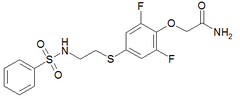PEPA is a sulfonamide AMPA receptor positive allosteric modulator,[1][2] which is up to 100 times more potent than aniracetam in vitro.[3] It produces memory-enhancing effects in rats when administered intravenously.[4]
 | |
| Clinical data | |
|---|---|
| Other names | PEPA |
| Legal status | |
| Legal status | |
| Identifiers | |
| |
| CAS Number | |
| PubChem CID | |
| ChemSpider | |
| UNII | |
| CompTox Dashboard (EPA) | |
| Chemical and physical data | |
| Formula | C16H16F2N2O4S2 |
| Molar mass | 402.43 g·mol−1 |
| 3D model (JSmol) | |
| |
| | |
See also
editReferences
edit- ^ Sekiguchi M, Takeo J, Harada T, Morimoto T, Kudo Y, Yamashita S, et al. (April 1998). "Pharmacological detection of AMPA receptor heterogeneity by use of two allosteric potentiators in rat hippocampal cultures". British Journal of Pharmacology. 123 (7): 1294–303. doi:10.1038/sj.bjp.0701707. PMC 1565288. PMID 9579722.
- ^ Sekiguchi M, Nishikawa K, Aoki S, Wada K (August 2002). "A desensitization-selective potentiator of AMPA-type glutamate receptors". British Journal of Pharmacology. 136 (7): 1033–41. doi:10.1038/sj.bjp.0704804. PMC 1573432. PMID 12145103.
- ^ Sekiguchi M, Fleck MW, Mayer ML, Takeo J, Chiba Y, Yamashita S, Wada K (August 1997). "A novel allosteric potentiator of AMPA receptors: 4--2-(phenylsulfonylamino)ethylthio--2,6-difluoro-phenoxyaceta mide". The Journal of Neuroscience. 17 (15): 5760–71. doi:10.1523/JNEUROSCI.17-15-05760.1997. PMC 6573208. PMID 9221774.
- ^ Sekiguchi M, Yamada K, Jin J, Hachitanda M, Murata Y, Namura S, et al. (September 2001). "The AMPA receptor allosteric potentiator PEPA ameliorates post-ischemic memory impairment". NeuroReport. 12 (13): 2947–50. doi:10.1097/00001756-200109170-00038. PMID 11588608. S2CID 42785890.